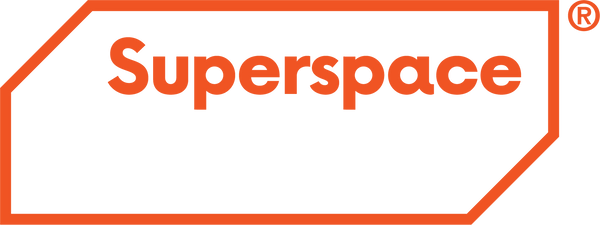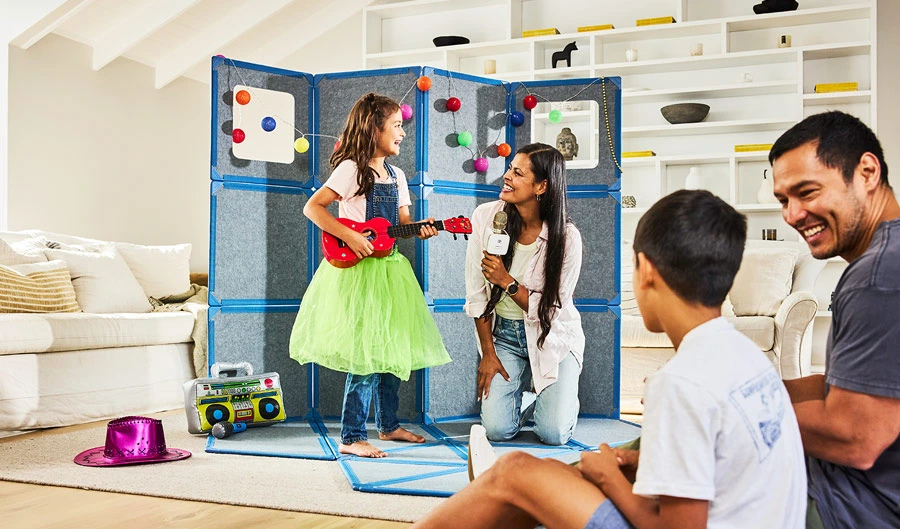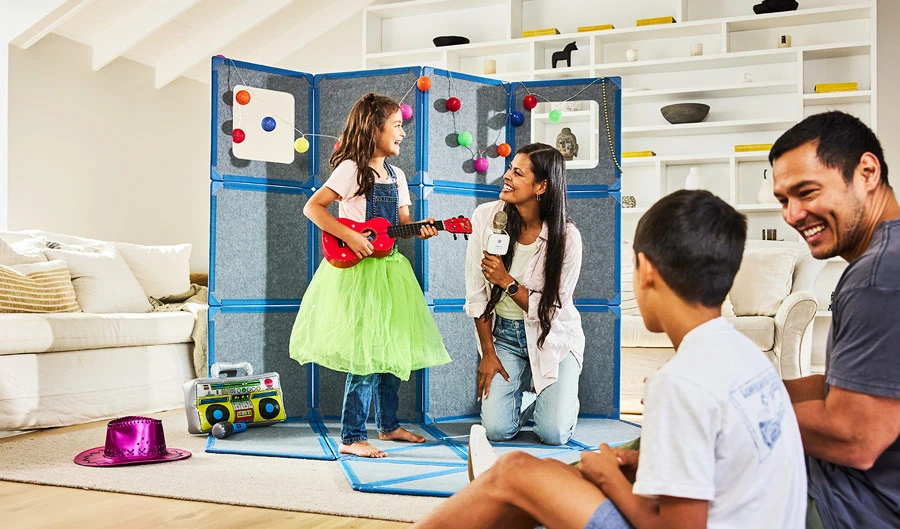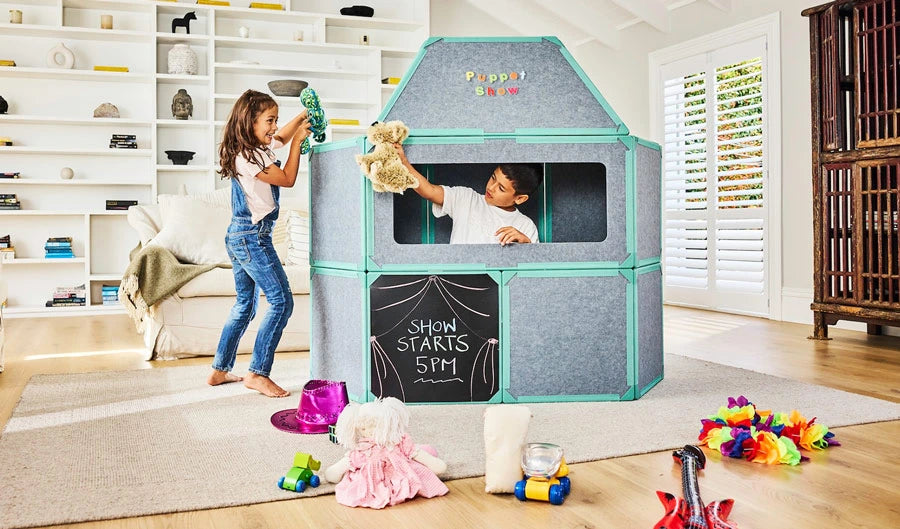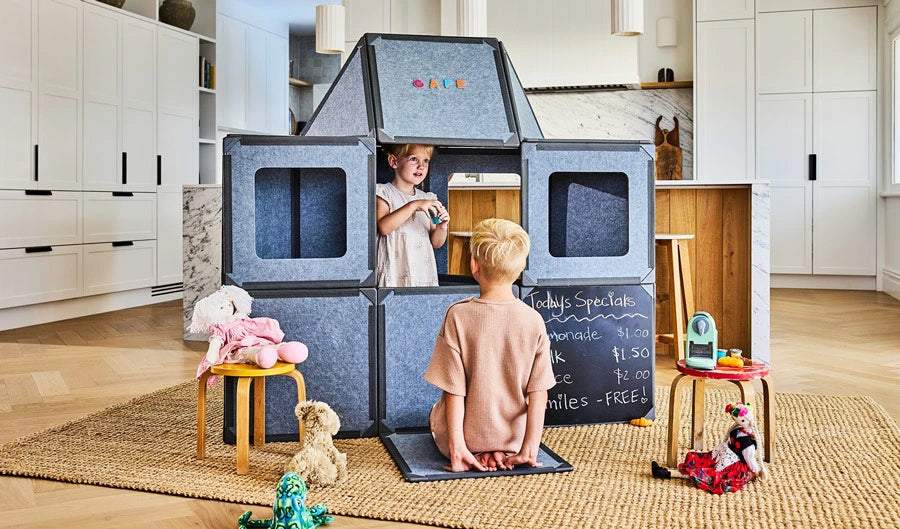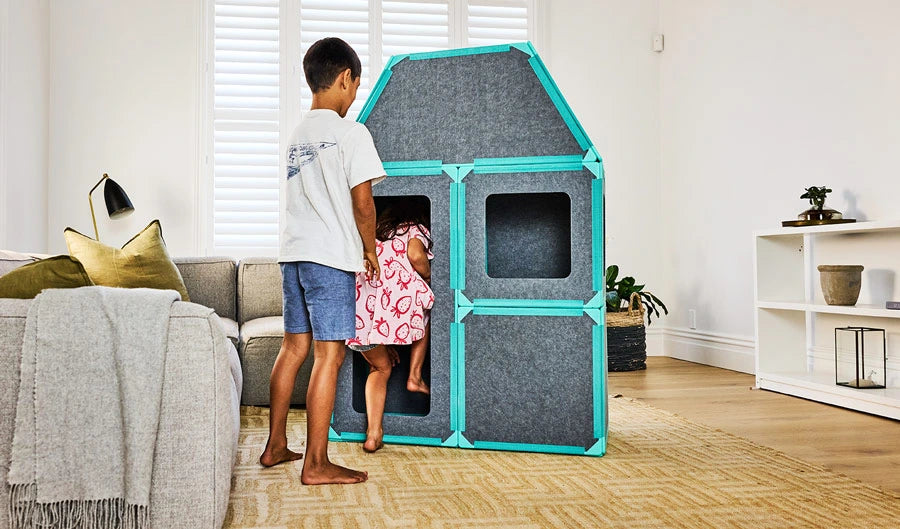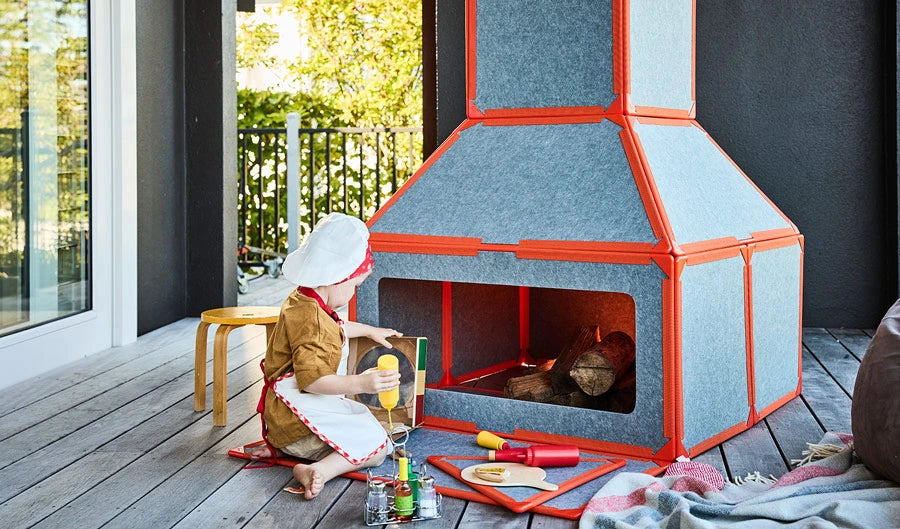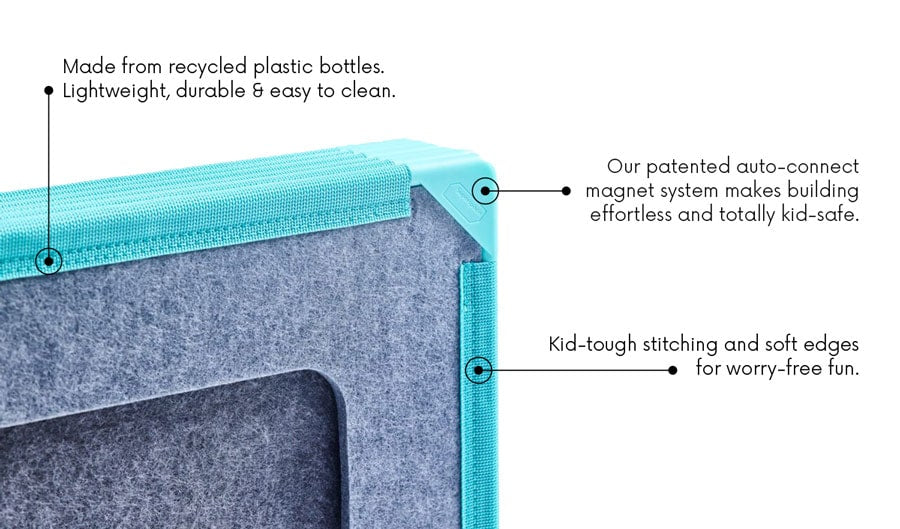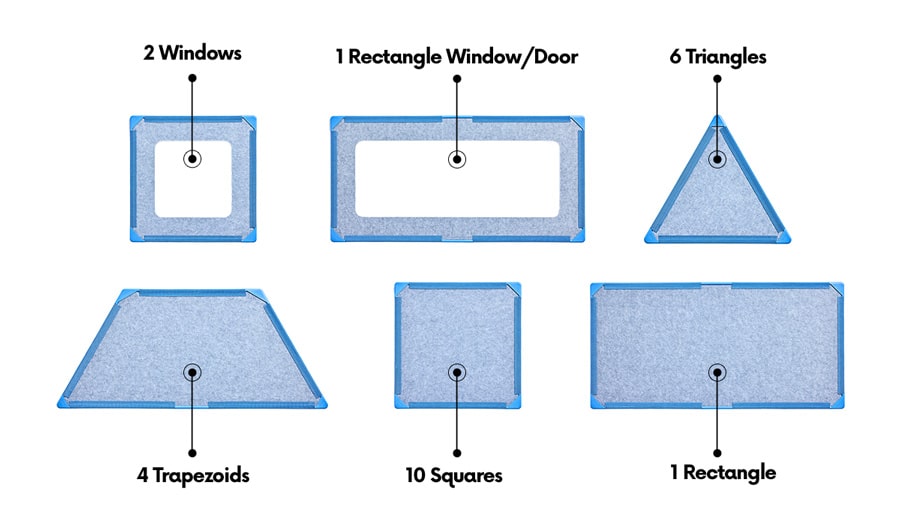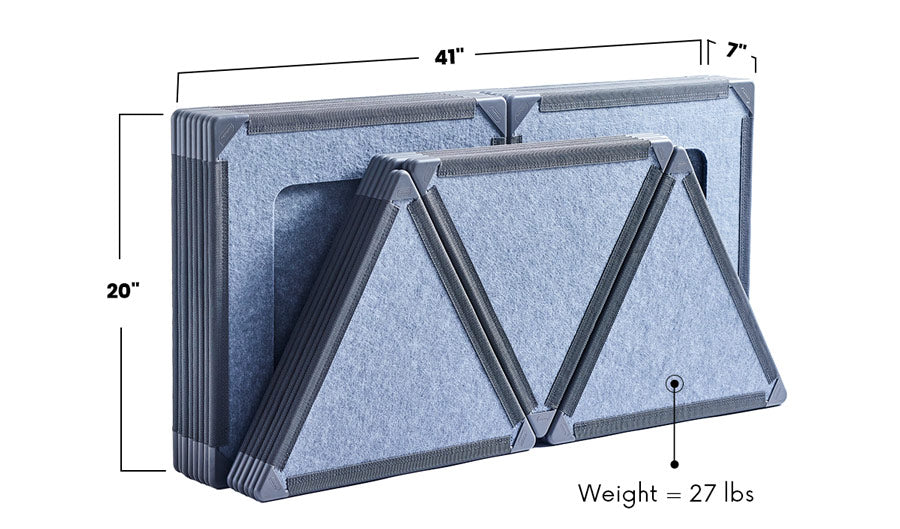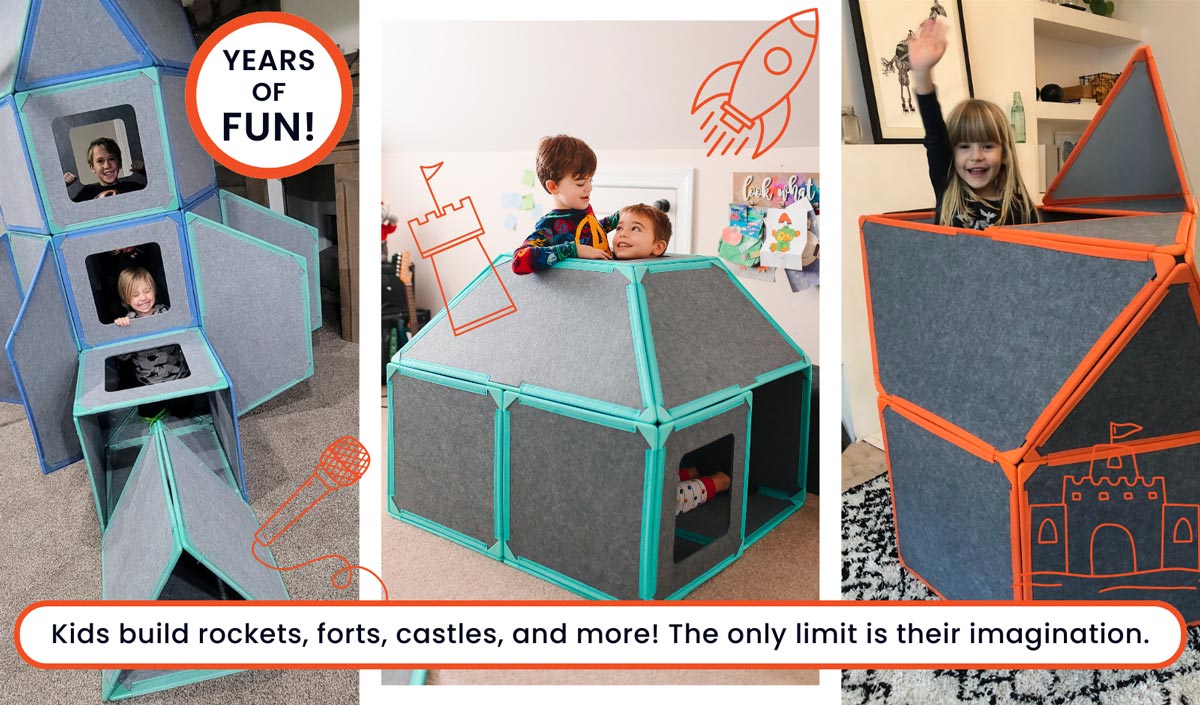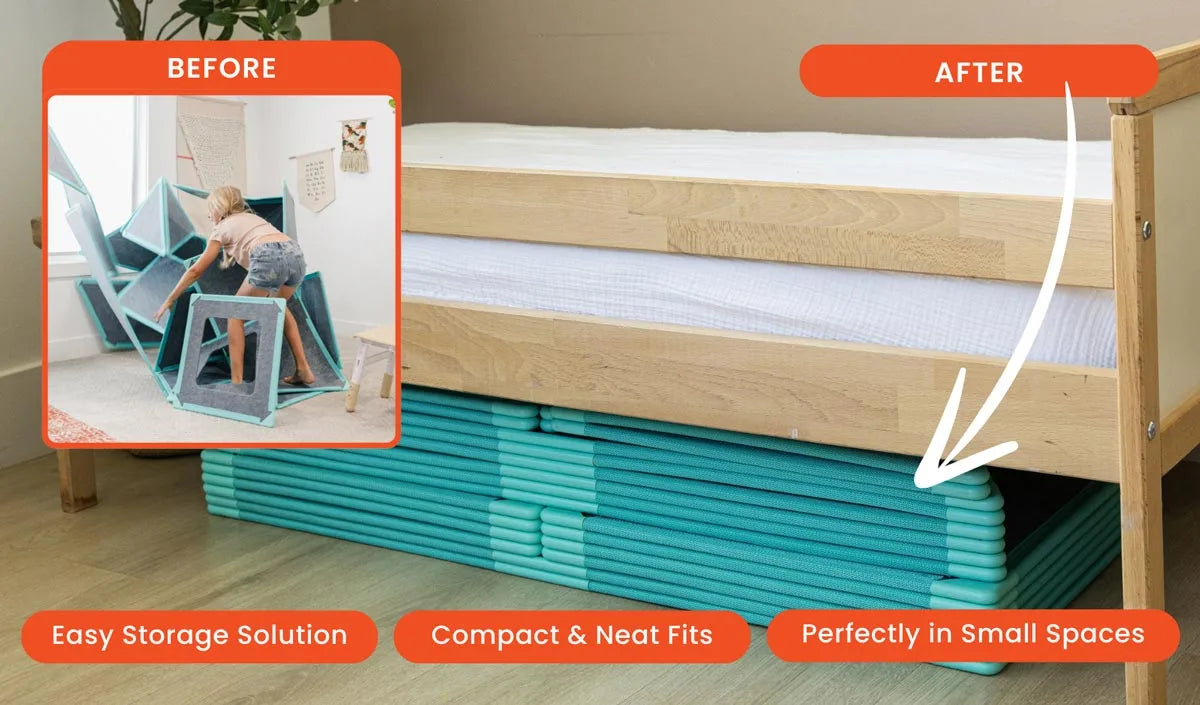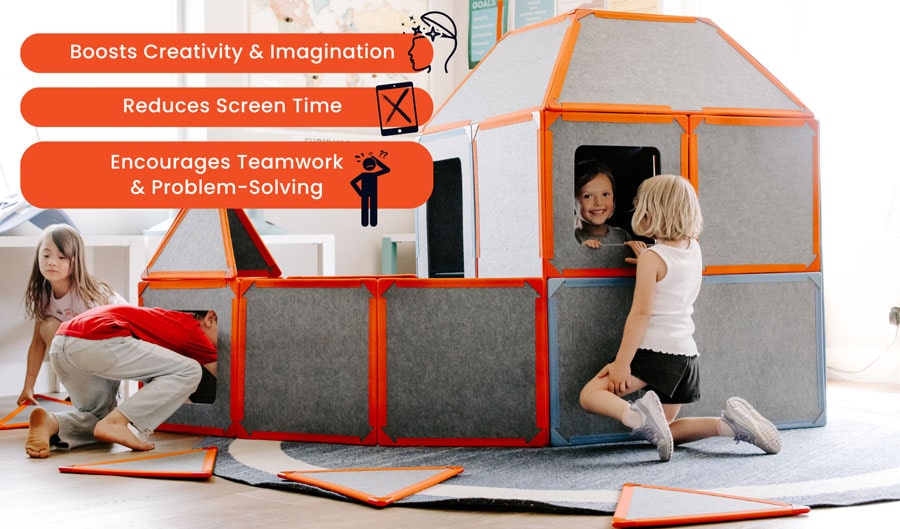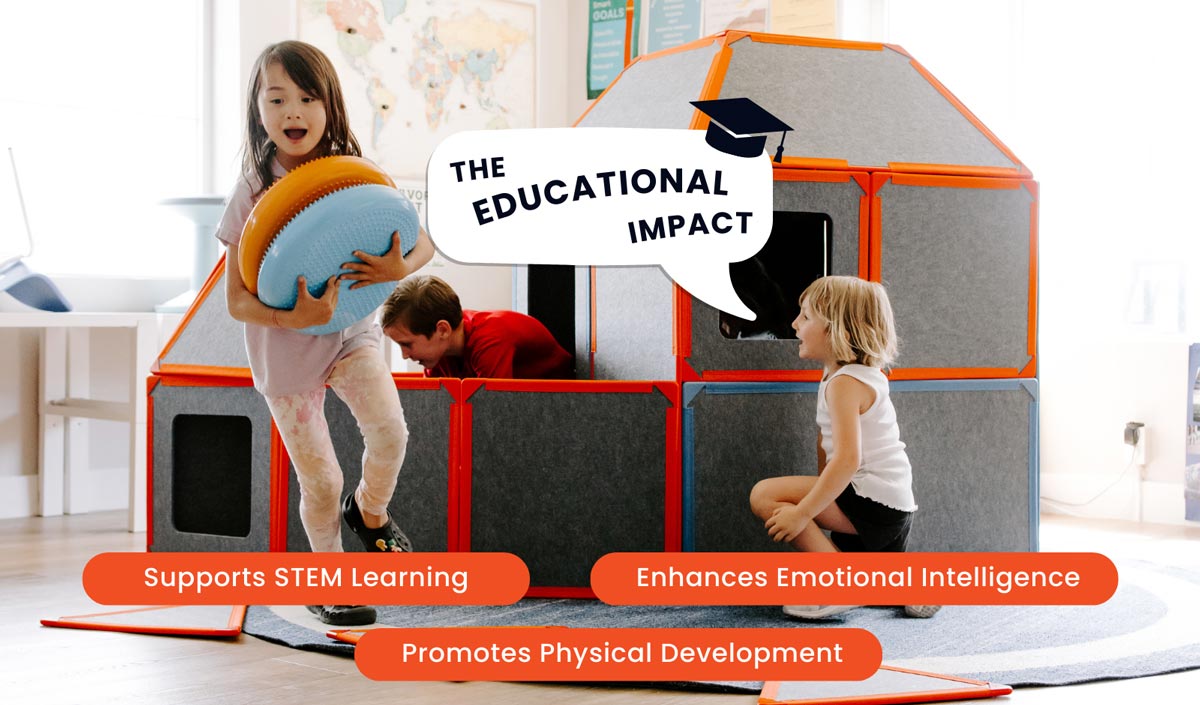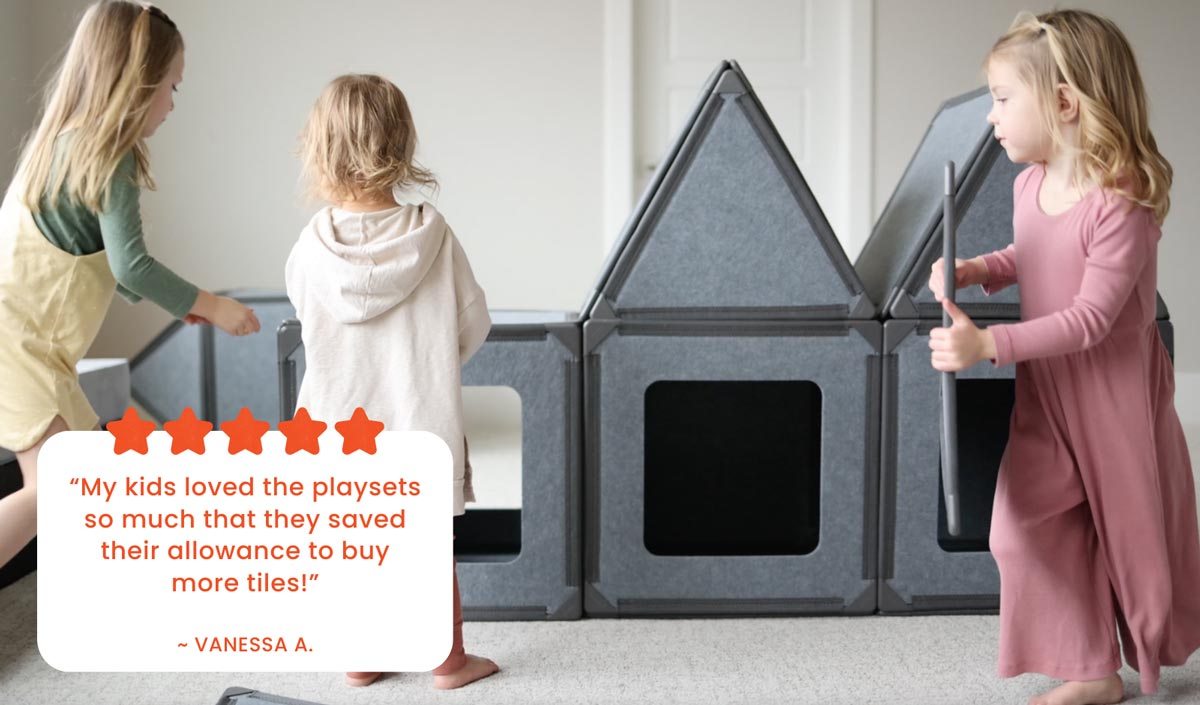Best Magnetic Building Toys for Kids 2025: Complete Guide
Ant ErwinAnother screen. Another collapse of cushions across the living room floor. You're exhausted, and you know your child needs something better.
Magnetic building toys transform screen time into hands-on creation. Research proves they boost spatial reasoning and future math performance [2].
But here's what most parents don't realize: there are two completely different categories.
Tabletop magnetic tiles develop fine motor skills for ages 3-6. Life-sized magnetic panels let children build forts they can actually enter. If your child has outgrown Magna-Tiles or constantly builds pillow forts, you need the life-sized option.
This guide reveals which magnetic building toys deliver real value, and which ones your child will use for years, not months.

Key Takeaways
- Two distinct categories: Tabletop magnetic tiles (ages 3-6, fine motor skills) vs. life-sized magnetic panels (ages 5-10+, gross motor development and full-scale building)
- Superspace is the only life-sized option. The sole magnetic building system children can actually enter and play inside, replacing collapsing pillow forts with stable structures
- Magna-Tiles remain the gold standard for preschool table play, while Connetix offers premium strength and safety features
- Look for sealed magnets, ASTM/CPSC certifications, and age-appropriate sizing in all magnetic building toys
- Premium options like Superspace cost just $61/year over 7 years of daily play, less than streaming subscriptions
- Spatial training with building materials improves mathematics performance and predicts future STEM success
Table of Contents
- Quick Comparison: Best Magnetic Building Toys at a Glance
- What to Look for in Magnetic Building Toys
- Best Magnetic Building Toys by Category
- Educational Benefits: Why Magnetic Building Toys Boost STEM Skills
- FAQs: Magnetic Building Toys & Safety
- Conclusion: The Best Magnetic Building Toys for Your Family
- References
Quick Comparison: Best Magnetic Building Toys at a Glance
Note: This guide covers two distinct categories – life-sized magnetic panels for full-scale forts (ages 5-10+) and tabletop magnetic tiles for table play (ages 3-6). They serve different developmental stages and are complementary, not competitive.
| Category | Best Option | Age Range | Price | Best For | Our Rating |
|---|---|---|---|---|---|
| LIFE-SIZED BUILDING | For children ready to build structures they can enter | ||||
| Life-Sized Magnetic Panels | Superspace Big Set | 3-10+ | $429 | Full-scale forts, replaces pillow forts, gross motor development | ⭐⭐⭐⭐⭐ |
| TABLETOP TILES | For preschool table play and fine motor skills | ||||
| Magnetic Tiles (Standard) | Magna-Tiles Classic 100pc | 3+ | $120 | Tabletop building, preschool education | ⭐⭐⭐⭐⭐ |
| Premium Magnetic Tiles | Connetix Tiles | 3+ | $40-180 | Stronger magnets, beveled safety edges | ⭐⭐⭐⭐ |
| Budget Magnetic Tiles | Picasso Tiles | 3+ | $20-60 | Value-conscious families | ⭐⭐⭐ |
What to Look for in Magnetic Building Toys
Choosing the right magnetic building toys for your child requires understanding what separates exceptional options from mediocre ones. The best magnetic building toys combine safety, educational value, and durability to deliver years of engaging play.
Safety Features and Age Appropriateness
Safety should be your first priority when selecting magnetic building toys. Look for toys with sealed magnets that cannot come loose, as loose magnets pose serious choking hazards if swallowed [1].
All quality magnetic toys should carry ASTM (American Society for Testing and Materials) and CPSC (Consumer Product Safety Commission) certifications.
Age-appropriate sizing matters significantly. Large magnetic panels like Superspace are designed for ages 3 and up with no small parts. Standard magnetic tiles are typically safe for ages 3 and older, while smaller magnetic building sets with tiny pieces should be reserved for children 5 and up. Always supervise toddlers during play, even with age-appropriate toys.
Check that magnetic connections are strong enough to hold structures together but not so powerful that young children struggle to separate pieces. The best magnetic building toys strike this balance perfectly.
Educational Value and STEM Benefits
The best magnetic building toys serve as powerful STEM learning tools. Research demonstrates that children who regularly engage with construction toys show significantly improved spatial reasoning skills, which predict future success in mathematics and engineering fields [2].
Magnetic building toys offer unique educational advantages. The instant feedback from magnetic connections helps children understand cause and effect. They learn about symmetry, balance, and geometric shapes through hands-on exploration. Open-ended magnetic toys encourage creative problem-solving rather than simply following instructions.
Look for magnetic building toys that grow with your child. Life-sized options like Superspace magnetic panels challenge children from age 3 (simple structures) through age 10 and beyond (complex architectural designs). This progression ensures continued engagement and learning across developmental stages.
Durability and Quality Materials
Premium magnetic building toys represent a significant investment, so durability matters. Quality magnetic tiles and panels should feature non-toxic, BPA-free plastics that won't crack or fade over years of use. Magnetic strength should remain consistent, not weaken over time.
Examine the magnetic connections carefully. Sealed, riveted magnets outlast glued magnets. Strong magnetic connections mean structures stay together during active play. Weak magnets lead to frustration when towers collapse unexpectedly.
The best magnetic building toys come with warranties and replacement part availability. This ensures your investment lasts through multiple children and years of enthusiastic play.

Best Magnetic Building Toys by Category
Based on extensive research and parent feedback, these are the top magnetic building toys in each category for 2025.
Best Life-Sized Magnetic Panels: Superspace Big Set ⭐
Why it's exceptional: Superspace Big Set stands alone as the only true life-sized magnetic building system for children. While magnetic tiles create tabletop structures, Superspace creates full-scale play spaces children can enter, transforming any room into an adventure.
What you get: 24 full-size panels ranging from 20x20 inches to 40x40 inches. Each panel features premium eco-felt material made from 130 recycled plastic bottles. Strong embedded magnets along all edges create instant, satisfying connections.
Age range: 3-10+ years (exceptional longevity) | Price: $429
What makes it stand out: The scale of creativity enabled by Superspace has no comparison in the magnetic building toys market. A 3-year-old builds a simple triangle tent. A 6-year-old constructs an elaborate castle with multiple rooms. A 10-year-old designs architectural structures with room dividers and secret passages. This progression ensures years of engaged play from a single set.
If your living room is a constant disaster zone of couch cushions and collapsing blanket forts, Superspace offers a transformation. Unlike pillow forts that collapse or cardboard boxes that bend and tear, Superspace panels stay upright and stable. Parents consistently report: "We used to tape boxes together... they had so much fun. I wish we would've had this back then."
The magnetic connections eliminate the frustration of daily fort rebuilding. Structures stay standing during active play, yet disassemble in minutes when playtime ends.
One parent noted: "It takes 2 minutes to clean up and stores easily – way better than pillows everywhere." The panels are lightweight enough for independent building but sturdy enough for hours of rough play.
If your child loves Magna-Tiles but constantly wants to build "something big enough to get inside," Superspace is the logical next step. The same satisfying magnetic click, scaled up to life-sized play.
One parent shared: "My kids loved Magna-Tiles, so I knew a giant version would be a hit. They call it 'kid-sized MagnaTiles!'"
Many families own both: Magna-Tiles for quiet table play and fine motor development (ages 3-6), and Superspace for active building and full-body imaginative play (ages 5-10+). They're complementary tools that develop different skills at different scales.
Pros:
- Life-sized structures children physically enter and inhabit
- Strongest magnetic connections in the industry (hold structures even during active play)
- Premium eco-felt material provides acoustic dampening and soft touch
- Promotes both fine and gross motor development
- Forbes-recommended for quality and educational value
- Perfect for multi-child collaborative play
- No small parts, making it safe for age 3+
- Panels store flat under beds or in closets
Cons:
- Premium investment ($429, though this equals $61/year over 7 years of play)
- Requires dedicated storage space (though panels are flat)
- Not portable for travel (panels are large)
Best for: Families seeking a premium, long-lasting magnetic building experience that grows with children. Ideal for parents who value open-ended play, screen-free engagement, and toys that encourage physical activity alongside creativity.
Learn more: For detailed information about fort building benefits and how Superspace compares to other fort systems, visit our fort building kits guide.

Best Value Life-Sized Option: Superspace Little Set ⭐
Perfect for families wanting to try life-sized magnetic building at a lower price point, the Superspace Little Set includes 16 panels for $279. This provides enough pieces for substantial forts and structures while allowing future expansion to the Big Set.
The Little Set uses identical quality materials and magnets as the Big Set. It's perfect for younger children (ages 3-6) or families with limited space. Many families start with the Little Set and expand once they see their children's engagement level.
Best Magnetic Tiles: Magna-Tiles Classic 100-Piece Set
Why it's the gold standard: Magna-Tiles invented the magnetic tile category and maintains its position through consistent quality, educational value, and universal compatibility.
What you get: 100 pieces including squares, triangles, and specialty shapes in translucent colors. Each tile features strong magnets along the edges that connect easily in any orientation.
Age range: 3+ years | Price: $120
What makes it stand out: Magna-Tiles' translucent design creates beautiful light effects when children build near windows or use light tables. The variety of shapes encourages mathematical thinking about geometry and symmetry. The brand's reputation means high resale value and wide availability.
Tabletop magnetic tiles excel at developing fine motor skills and spatial reasoning. The smaller scale allows for intricate architectural details. Children learn about 2D shapes that fold into 3D structures, a key mathematical concept. Most sets include squares, triangles, and specialty shapes that connect in countless combinations.
Pros:
- Industry-standard quality with proven durability
- Widely used in schools and educational settings
- Compatible with most other magnetic tile brands
- Clear colors allow light play and color mixing
- Strong magnets that hold structures firmly
- Dishwasher-safe for easy cleaning
- Extensive shape variety available in expansion sets
Cons:
- Premium price compared to generic alternatives
- Magnets slightly weaker than Connetix
- Standard edges (not beveled like Connetix)
Best for: Families wanting the proven standard in magnetic tiles. Perfect for educational settings, homeschoolers, and parents who value brand reputation and compatibility.
Best Premium Magnetic Tiles: Connetix Tiles
Why it's exceptional: Connetix represents the premium evolution of magnetic tiles with stronger magnets, beveled edges for safety, and vibrant colors.
Age range: 3+ years | Price range: $40-180 (depending on set size)
What makes it stand out: Connetix tiles feature the strongest magnets in the magnetic tile category, meaning structures hold together better during active play. The beveled edges reduce sharp corners, making them safer for toddlers. Colors are more vibrant and opaque than Magna-Tiles.
Pros:
- Strongest magnetic connections among all tile brands
- Beveled edges improve safety and aesthetics
- Brighter, more vibrant colors
- Compatible with Magna-Tiles and other brands
- Premium quality materials and construction
Cons:
- Higher price than generic alternatives
- Less widely available than Magna-Tiles
Best for: Families wanting the absolute best quality in magnetic tiles. Ideal for households with very young children (beveled edges), active builders (stronger magnets), or those seeking vibrant aesthetics.
Comparison: Magna-Tiles vs Connetix
Note: This comparison is for parents choosing tabletop magnetic tiles for ages 3-6. If you're looking for full-scale building your child can enter, see Superspace above – it occupies a completely different category (life-sized vs. tabletop).
| Feature | Magna-Tiles | Connetix |
|---|---|---|
| Magnet Strength | Good | Strongest |
| Edge Design | Standard | Beveled (safer) |
| Color Vibrancy | Translucent, subtle | Bright, vibrant |
| Price (100pc) | $120 | $140-160 |
| Availability | Widely available | Growing availability |
| Best For | Classic choice, education | Premium quality, safety |
Both are excellent choices. Magna-Tiles wins on availability and brand recognition. Connetix wins on magnet strength and safety features. You cannot go wrong with either.
Bottom line: Both Magna-Tiles and Connetix are excellent tabletop options for preschool-aged children developing fine motor skills. Many families own both brands (they're compatible) and later add Superspace when children outgrow table-sized building and want to create structures they can enter.
Best Budget Magnetic Tiles: Picasso Tiles
For value-conscious families, Picasso Tiles delivers magnetic building fun at a fraction of premium prices. Sets range from $20-60 and provide full compatibility with Magna-Tiles.
Quality is good (not exceptional), with adequate magnet strength for most building. Colors are bright and children cannot tell the difference from premium brands. This makes Picasso Tiles perfect for starting out or expanding existing collections affordably.
The main trade-off is durability. Premium brands outlast budget options by years. However, for families unsure about their child's interest level, Picasso Tiles provides a low-risk entry point.

Other Building Toy Categories Worth Considering
While magnetic building toys offer unique advantages, several other categories complement them well:
LEGO Classic: The precision brick system offers unmatched versatility for ages 4+. Perfect for developing patience and detailed construction skills. Price range: $20-300.
Fort Building Kits: Rod-and-connector systems like Fort Magic ($100-200) create frameworks for sheet-draping forts. More budget-friendly than Superspace but require sheets and more complex assembly. For comprehensive fort building comparisons, see our fort building kits guide.
STEM Building Sets: K'NEX, Engino, and robotics kits explicitly focus on mechanical engineering. Ages 5+, $40-150. While excellent for specific STEM learning, these offer less open-ended play than magnetic building toys.
Wooden Blocks: Melissa & Doug and other wooden unit blocks remain staples for ages 2+. Timeless, durable, and teach fundamental concepts about balance and gravity. Price range: $20-100.
Educational Benefits: Why Magnetic Building Toys Boost STEM Skills
The educational benefits of magnetic building toys extend far beyond simple play. Research demonstrates measurable impacts on cognitive development and future academic success.
Spatial Reasoning Development
Spatial reasoning, the ability to mentally manipulate 2D and 3D objects, predicts later success in mathematics and engineering more strongly than verbal or numerical skills in early childhood [4].
Magnetic building toys develop spatial reasoning through constant practice. When a child connects two magnetic tiles to form a corner, they visualize how flat shapes create three-dimensional objects. This mental rotation and transformation builds critical neural pathways.
A comprehensive meta-analysis of 29 studies found that spatial training with building materials improved mathematics performance, with an average effect size of 0.28 [2]. The benefits persisted through elementary school and were strongest for children who started building play before kindergarten.
Life-sized magnetic building amplifies these benefits. Children planning structures they can enter must consider scale, proportion, and functionality at a level impossible with miniature building. A fort must be tall enough to sit in, wide enough to move through. These real-world constraints teach practical engineering concepts.
Fine Motor Skills and Problem-Solving
Fine motor skills develop through repetitive practice. Magnetic building toys provide engaging fine motor exercise disguised as play. Grasping magnetic tiles, aligning edges precisely, and pulling apart strong magnetic connections all build hand strength and coordination essential for writing and daily tasks.
Research shows children who regularly engage with construction toys demonstrate measurably better fine motor control than peers focused on screen-based play [5]. The three-dimensional manipulation develops hand-eye coordination more effectively than flat, two-dimensional touch screens.
Open-ended magnetic building toys develop problem-solving skills by presenting endless challenges without prescribed solutions. When a magnetic tile tower falls over, a child experiments with different base designs. When a Superspace fort won't stand, they problem-solve by adding support panels. This iterative design process mirrors real-world engineering challenges.
Research-Backed Long-Term Benefits
Multiple peer-reviewed studies confirm the educational value of magnetic building toys:
Mathematics Performance: A 2017 study in Cognitive Development found that spatial training with building toys significantly improved mathematics performance in elementary students [4]. The effect was strongest for children who started building play before kindergarten.
STEM Career Interest: Longitudinal research tracking children from preschool through high school found that early building toy play was among the strongest predictors of STEM career interest, particularly in engineering and architecture [9].
Executive Function: Research from the LEGO Foundation demonstrates that children who regularly engage with open-ended building toys show stronger executive function skills, including planning, working memory, and cognitive flexibility [6]. These skills predict academic and life success more reliably than IQ scores.
The evidence is clear. Magnetic building toys provide measurable educational benefits that extend well beyond childhood play. These toys represent investments in cognitive development, not mere entertainment.

FAQs: Magnetic Building Toys & Safety
Q: What are the best magnetic building toys?
A: The best magnetic building toys for kids in 2025 include:
- Superspace Big Set: Best for life-sized structures children can enter (ages 3-10+)
- Magna-Tiles Classic 100-Piece: Best magnetic tiles for education and play (ages 3+)
- Connetix Tiles: Premium magnetic tiles with strongest magnets and beveled edges (ages 3+)
- Superspace Little Set: Best value for life-sized magnetic building (ages 3-10+)
- Picasso Tiles: Budget-friendly magnetic tiles compatible with premium brands (ages 3+)
The best choice depends on your priorities. For life-sized building that encourages physical play, choose Superspace. For tabletop building with proven educational value, choose Magna-Tiles. For premium quality and safety, choose Connetix. For budget-conscious families, choose Picasso Tiles.
Q: Are magnetic building blocks safe for kids?
A: Yes, magnetic building toys are safe for kids ages 3 and up when manufactured properly and used according to age recommendations.
Look for these safety features:
- Sealed magnets that cannot come loose or be removed
- ASTM and CPSC safety certifications
- Age-appropriate sizing (no small parts for children under 3)
- Strong magnetic connections (pieces don't separate too easily)
- Non-toxic, BPA-free materials
Always supervise toddlers during play, even with age-appropriate magnetic toys. Never allow children under 3 to play with small magnetic tiles. Choose large-piece options like Superspace panels or toddler-specific magnetic toys for younger children.
Immediately discard any magnetic toy showing exposed or loose magnets. Swallowing multiple magnets poses serious medical dangers.
Q: What age are magnetic tiles for?
A: Different magnetic building toys suit different age ranges:
| Magnetic Toy Type | Recommended Age | Why |
|---|---|---|
| Large magnetic panels (Superspace) | 3-10+ years | Life-sized building, no small parts, gross motor development |
| Standard magnetic tiles (Magna-Tiles) | 3+ years | Standard tile size, sealed magnets, fine motor skills |
| Magnetic blocks for toddlers (Grippies) | 18 months+ | Larger pieces, textured grip, baby-safe |
| Small magnetic building sets | 5+ years | Complex builds, smaller connector pieces |
Most magnetic tiles are designed for ages 3 and up. The pieces are large enough to prevent choking but small enough for developing fine motor skills. Children as old as 12+ still enjoy magnetic tiles for artistic and geometric creations.
Life-sized magnetic panels like Superspace offer the longest age range (3-10+ years) because the scale of building grows more complex as children develop. A 3-year-old builds simple triangle tents. A 10-year-old designs multi-room architectural structures.
Q: Which is better: MAGNA-TILES or Connetix?
A: Both Magna-Tiles and Connetix are excellent premium magnetic tiles. The best choice depends on your priorities:
| Feature | Magna-Tiles | Connetix |
|---|---|---|
| Magnet Strength | Good, holds well | Strongest available |
| Edge Design | Standard square edges | Beveled edges (safer, prettier) |
| Color Style | Translucent, classic | Vibrant, more opaque |
| Price (100pc) | $120 | $140-160 |
| Availability | Widely available everywhere | Growing availability |
| Best For | Classic choice, educational settings | Premium quality, families with toddlers |
Magna-Tiles wins if: You want the established standard, plan to buy expansion sets everywhere, or prefer translucent tiles for light play.
Connetix wins if: You want the strongest magnets, safer beveled edges, or brightest colors.
You cannot make a wrong choice between these two brands. Both are fully compatible with each other and other magnetic tile brands. Many families own both and combine them.

Q: Should I get Magna-Tiles or Superspace?
A: These serve different purposes. Magna-Tiles are for ages 3-6 tabletop play developing fine motor skills. Superspace is for ages 3-10+ full-body fort building.
Choose Magna-Tiles if your child: Enjoys quiet seated play, is developing fine motor skills, or has limited space for large structures.
Choose Superspace if your child: Constantly builds pillow forts, needs active full-body play, wants to build structures they can enter, or has outgrown tabletop toys.
Get both if: Your child enjoys both quiet table play and active fort building. They're complementary, not competitive.
Budget priority: If you can only afford one and your child is 3+, prioritize Superspace. The life-sized scale offers unique benefits that nothing else provides.
Q: Are expensive building toys worth it?
A: Premium magnetic building toys often provide significantly better value than cheap alternatives when you calculate cost-per-year of use.
Example: Superspace Big Set
- Initial cost: $429
- Typical use span: 7+ years (ages 3-10+)
- Cost per year: $61
- Cost per month: $5.08
Compare this to cheap toys purchased impulsively. A $30 toy used for 3 months costs $120 per year. A $60 toy used for 6 months costs $120 per year.
Premium building toys deliver value through:
- Longer lifespans (5-10+ years vs. 1-2 years)
- Higher engagement (used daily vs. weekly)
- Better quality materials (won't break or weaken)
- Multi-child use (serve siblings across years)
- Higher resale value (premium brands hold value)
The most expensive toy is the one that sits unused. A $20 toy never played with costs infinitely more than a $400 toy used daily for years.
Calculate the cost-per-year before purchasing. Premium often becomes budget when you consider actual use time.
Q: What are the benefits of magnetic building toys?
A: Research demonstrates that magnetic building toys provide measurable educational and developmental benefits:
Cognitive Development:
- Improve spatial reasoning and mathematics performance through hands-on construction play [2]
- Develop geometric and mathematical thinking through hands-on shape exploration
- Build problem-solving skills through trial-and-error experimentation
- Enhance executive function (planning, working memory, cognitive flexibility)
Physical Development:
- Strengthen fine motor skills through grasping, aligning, and connecting pieces
- Develop hand-eye coordination through precise manipulation
- Build gross motor skills with life-sized building (Superspace)
- Improve bilateral coordination (using both hands together)
Social-Emotional Development:
- Encourage collaborative play and teamwork
- Build confidence through successful creation
- Develop patience and persistence when designs fail
- Create opportunities for imaginative play and storytelling
Academic Benefits:
- Predict future mathematics success more reliably than early numeracy skills [4]
- Correlate with increased interest in STEM careers [9]
- Support engineering thinking and design processes [7]

Conclusion: The Best Magnetic Building Toys for Your Family
Choosing the right magnetic building toys transforms playtime into powerful learning experiences. The research is clear: children who regularly engage with quality building toys develop stronger spatial reasoning, better fine motor skills, and increased interest in STEM fields.
The magnetic building toys market offers options for every family budget and play style. For tabletop building with proven educational value, Magna-Tiles remains the gold standard.
For families wanting premium quality and safety features, Connetix delivers the strongest magnets and beveled edges. Budget-conscious families find excellent value with Picasso Tiles.
For a life-sized building that enables physical play and imaginative exploration at unprecedented scale, Superspace magnetic panels stand alone in the market. No other magnetic building toy allows children to create full-sized structures they can actually enter and inhabit. This unique capability delivers developmental benefits impossible with miniature building.
The best magnetic building toy is the one your child will use daily for years. Consider your child's age, interests, and play style. Think about space, budget, and growth potential. Choose quality over quantity. A single exceptional building toy system delivers more value than a dozen mediocre options.
Remember that premium building toys represent investments in development, not mere purchases. Calculate the cost per year over the toy's lifespan.
A $429 Superspace Big Set used daily from age 3 to 10 costs just $61 annually. That's less than many streaming subscriptions or monthly coffee habits.
Screen-free play with magnetic building toys creates memories, develops skills, and provides the kind of hands-on learning that prepares children for future success. Whether you choose magnetic tiles for tabletop exploration or life-sized panels for full-scale building, you're giving your child tools that will serve them for years to come.
Remember the two distinct categories: If your child is ages 3-6 and developing fine motor skills through table play, magnetic tiles (Magna-Tiles, Connetix, or Picasso) are excellent choices. If your child is ages 5-10+ and ready for full-body, active play, especially if they're constantly building pillow forts or have outgrown tabletop toys, Superspace's life-sized magnetic panels offer a unique category of play that nothing else provides. Many families discover they want both, as they serve different developmental needs and complement each other beautifully.
Ready to get started? For families seeking premium life-sized magnetic building, explore the Superspace Big Set or Superspace Little Set. For detailed guidance on fort building benefits and options, visit our fort building kits guide. Your child's next great building adventure awaits.
References
- U.S. Consumer Product Safety Commission. (2022). Safety Standard for Magnets, 16 CFR Part 1262. Federal Register. https://www.cpsc.gov/Business--Manufacturing/Business-Education/Business-Guidance/Magnets
- Hawes, Z., Gilligan-Lee, K. A., & Mix, K. S. (2022). Effects of spatial training on mathematics performance: A meta-analysis. Developmental Psychology, 58(1), 112-137. https://doi.org/10.1037/dev0001281
- Verdine, B. N., Golinkoff, R. M., Hirsh-Pasek, K., Newcombe, N. S., Filipowicz, A. T., & Chang, A. (2014). Deconstructing building blocks: Preschoolers' spatial assembly performance relates to early mathematical skills. Child Development, 85(3), 1062-1076. https://doi.org/10.1111/cdev.12165
- Hawes, Z., Gilligan-Lee, K. A., & Mix, K. S. (2022). Effects of spatial training on mathematics performance: A meta-analysis. Developmental Psychology, 58(1), 112-137. https://doi.org/10.1037/dev0001281
- Cameron, C. E., Brock, L. L., Murrah, W. M., Bell, L. H., Worzalla, S. L., Grissmer, D., & Morrison, F. J. (2012). Fine motor skills and executive function both contribute to kindergarten achievement. Child Development, 83(4), 1229-1244. https://doi.org/10.1111/j.1467-8624.2012.01768.x
- Zosh, J. M., Hopkins, E. J., Jensen, H., Liu, C., Neale, D., Hirsh-Pasek, K., Solis, S. L., & Whitebread, D. (2017). Learning through play: A review of the evidence (White paper). The LEGO Foundation, DK. https://www.legofoundation.com/en/learn-how/knowledge-base/learning-through-play
- Sorby, S. A. (2009). Educational research in developing 3-D spatial skills for engineering students. International Journal of Science Education, 31(3), 459-480. https://doi.org/10.1080/09500690802595839
- Russ, S. W., & Wallace, C. E. (2013). Pretend play and creative processes. American Journal of Play, 6(1), 136-148. Available at Journal of Play
- Wai, J., Lubinski, D., & Benbow, C. P. (2009). Spatial ability for STEM domains: Aligning over 50 years of cumulative psychological knowledge solidifies its importance. Journal of Educational Psychology, 101(4), 817-835. https://doi.org/10.1037/a0016127
